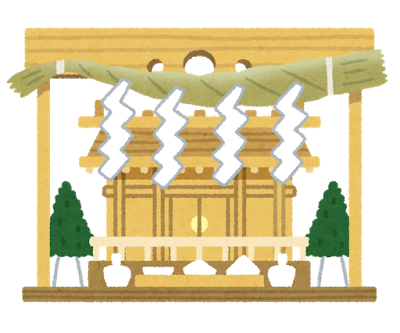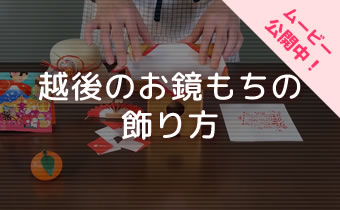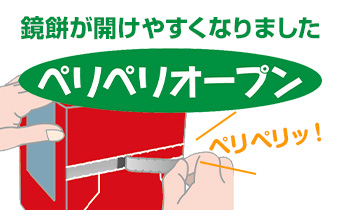- Home
- Know / Enjoy
- Encyclopedia of rice cakes and rice
- About mirror mochi
There are various theories about the content of the articles posted, so please refer to them for reference only.
How long have you been decorating your mirror mochi?
-

The origin of Kagami mochi is unknown in detail.A picture of Kagami mochi is drawn in a book from the Genroku era (around 1690).It seems that there was a custom of decorating Kagami mochi around this time.
Why do you decorate the mirror mochi?
-

Mochi has long been said to be a sacred food dedicated to God on Halle's day.Kagami mochi is a New Year's decoration that offers mochi to the gods and Buddha, and is offered to welcome the grain god "Toshigami".The old god is said to be the god who brings the new year.
Since ancient times, it has been said that God dwells in mirrors (bronze mirrors) and has been offered to God.It is said that the round rice cake resembles a bronze mirror, and the round shape represents the harmoniousness of the family, and the layered appearance means "to pile up fortune and to grow older."Generally, there are two stages, large and small.Represents the moon and the sun, yin and yang.
In the olden days, there were several rice cake shops in the town (shops that make rice cakes), and they used to make red rice and rice cakes for celebrations and New Year holidays.However, the mochi becomes moldy and deep blue in a few days.Therefore, the mochi maker released a specially packed kagami mochi around XNUMX to make a mold-free kagami mochi.At the supermarket, I wanted a mold-free kagami mochi, so it spread all over the country in a short time.Nowadays, it is common to buy kagami mochi at supermarkets and home improvement stores.
Where is the right place to display the mirror mochi?
-
It can be offered to places where gods are worshiped (tokonoma, kamidana, water gods, fire gods), places where you want to get rid of evil, important things and tools.
The belief in Japan has been that God dwells in everything that surrounds our lives. There are so many gods that they are said to be "eight million gods."It is thought that it is a manifestation of the culture peculiar to Japanese people who give thanks to things and love things by offering kagami mochi to tools and kitchens.
The recent trend seems to be to decorate the entrance and living room due to reasons such as nuclear families and housing conditions such as condominiums (there is no Kamidana). How long do you decorate your mirror mochi?
-
It's okay to decorate the kagami mochi at the earliest, but it seems that "Daian Day" and "December XNUMX" are often the best. It is said that "eight" is a good number in Japan because it spreads toward the end, and it seems to be displayed on auspicious days.
It is said that you should not decorate Kagami Mochi on December 12th and 29st. On the 31th, 29 is "suffering" and leads to suffering, so it is unlucky, and on the 9st, it is said to be an overnight decoration. There is a theory that it should be avoided because it leads to "one night decoration".The date of opening the mirror varies depending on the region, but it is generally January XNUMXth.The custom of lowering the kagami mochi offered to God on January XNUMX and eating it is called kagami biraki.It is believed that you will benefit from eating the rice cakes that God dwells in.
How do you make a mirror mochi?
-

Soak glutinous rice in water overnight, drain it, steam it with steam, and beat the rice cake with a mortar and pestle.Cut into two pieces, large and small, and round.Let it cool overnight to harden it.When decorating between the alcove, lay a sheet of paper (red on all sides) on three sides and serve rice cakes on top of each other.The decorations include "shide," "orange," "suehiro," and "kelp," and the customs differ depending on the region and home.
Please tell me the correct way to eat Kagamimochi.
-
It is customary to eat kagami mochi by breaking it with a hand or a mallet without cutting it with a knife. I hate the word "cut" and use the auspicious word "open".
When is the mirror opening? What does it mean?
-

In the Kanto region, "Matsunouchi" is until January 1th, when the old god is here.Kagami mochi offered to God will be lowered and eaten on January 7th, when the pine trees are open.This custom is called Kagami biraki.
In regions where the 15th is in Kadomatsu, the mirror opening may be done on the 15th or 20th.It will be held on January 1th in Kyoto.
Kagami mochi is the place where the old god who came into the house stays until the day he returns to the mountain.It is believed that you will benefit from eating the rice cakes that God dwells in.Kagami mochi is a custom of eating by breaking it with a hand or a mallet without cutting it with a knife. I hate the word "cut" and use the auspicious word "open". What does orange on a mirror mean?
-

After the blue fruits ripen reddish and yellow in winter, the oranges do not fall and remain on the branches in spring, and return to green fruits in the next summer.It is said that once the fruit is produced, it will not fall for more than XNUMX to XNUMX years.In this way, many generations of oranges are still attached to the branches, and new fruits are added to form a single tree, which makes it look like a healthy and long-lived family, and wishes for longevity and prosperity for generations.
How do you fold a calligraphy with a mirror?
-
Kagami mochi to be offered between the floors is decorated by laying a piece of paper on a table called Mikata.For the calligraphy, we use four-sided red, which has four sides bordered in red.Shikata Beni is a prayer for the prosperity of the year after the disaster.
If you don't have four-sided red, cut a piece of calligraphy paper into a square and use it.Lay the square calligraphy on the front of the three sides so that the corners come.
If you want to serve a small kagami mochi on the Kamidana, cut a piece of paper into squares or rectangles and place the kagami mochi on it.If you cut it into a rectangle, you can serve it so that a piece of paper hangs down from the Kamidana. I want to know the correct way to decorate the Kamidana with mirrors!
-
The arrangement of offerings on the Kamidana differs depending on the region, but the basic arrangement is "rice" in the center, "salt" on the right, and "water" on the left.
In addition, on the 1st and 15th of every month, at the time of worship of Ujigami and celebrations at home, miki, sake, and fish with a tail!We offer vegetables and fruits.In that case, "rice" is on the left front, "salt" is on the right, "water" is in the center, and "liquor" is on the far left and right.
Kagami mochi is served in front of the center of them using a sheet of paper or three sides. Why do you decorate kelp on the mirror mochi?
-
Meaning of "joy".In the olden days, kelp was called "Hirome", and it is a lucky charm that spreads joy. It also means to write "kobu" and wish to be blessed with child treasure.
Is Kagami biraki different in Kanto and Kansai?
-
The time to remove the New Year's decorations depends on the region.In the Kanto region, "Matsunouchi", which decorates Kadomatsu, is open until the XNUMXth of New Year.In Kansai, the period until the XNUMXth is Matsunouchi.There are various theories about this difference, but it seems that the old Kagami biraki was January XNUMXth.However, since Tokugawa Iemitsu died on April XNUMX, he thought that it was not good to open the mirror on the anniversary of the death of the moon, "XNUMXth". It means that it has changed.
This is not well communicated, and it is said that the Kansai area is "Matsunouchi" until the XNUMXth, and the mirror opens on the same day.
In addition, there are some areas where "Matsunouchi" is until January XNUMXth, so it is best to match the customs of your city area. Please tell me the correct way to decorate the mirror.
-
Generally, a white memorial paper or Japanese paper called Shihobeni, which is used in Shinto rituals and is used in Shinto rituals, is laid on a table called Sanpo. Place kagami mochi on paper shide, urajiro, and yuzuriha, and decorate with kelp, orange, and so on.
There are various ways to decorate depending on the region and the house, and there are also places where lucky things such as dried persimmon, katsuguri, XNUMX rice, black beans, dried squid, and spiny lobster are served. What are the leaves to decorate under the mirror?
-
Decorate the "Yuzuri leaf".It is derived from the fact that old leaves fall after new leaves come out.I hope that the family will be transferred from parent to child and will continue for generations.
"Decorate a fern called Urajiro. It means that new leaves will gradually grow along with old leaves, so it will prosper for a long time.
Since the back of the leaf is white, I hope that there is no back in my heart, that I wish for innocence, and that I wish for a long life until my hair turns gray again. (Formally, the white side is displayed in front.) Please tell me how to clean up the mirror.
-
January XNUMXth is the day when the Kagami-mochi offered by Kagami-biraki is lowered and the family benefits from God.
The accessories after being lowered by opening the mirror will be fired when the fire festival events held in the New Year are held in various places.
It used to be an event held at shrines and rice fields (after harvesting) on the morning of January 1th or 14th, and it is a Shinto ritual that burns the beginning of writing in addition to New Year's decorations such as shimenawa and shimenawa.
In recent years, the number of shrines and temples that are fired due to environmental concerns and the prohibition of open burning is decreasing.In addition, plastic containers may be refused to be brought in, so it seems that there are many places where they are put out as separated garbage according to the classification of local governments and municipalities.I'm reluctant to put out what I have decorated with God with garbage.In such a case, it may be good to wrap it in white paper, convey gratitude, and wrap it with clean salt to distinguish it from ordinary garbage.
Which is the correct place to display the mirror mochi, the Kamidana or the Buddhist altar?
-
Kagami mochi is basically offered at the [main place] of your home or company.
Place one large kagami mochi between the entrance and the alcove.
Small kagami mochi should be placed on the Kamidana or Buddhist altar. How do you choose the size of your mirror?
-
The basic feeling of offering Kagami Mochi is "gratitude."There is no particular limitation on the location or size of the offering.
Please tell me the meaning of the three sides on which the mirror mochi is placed.
-
The platform on which the Shinsen (a meal presented to God) is placed is called Mikata.
The decoration is said to be offered with the three sides and the side with the seams on the edge of the fold facing the front. I want to know how to put out and cut a vacuum packed mirror!
-
Echigo Seika's "Push-only Pon" opens the bottom lid and pushes out the rice cake inside from the top of the container.
For "Open and Pon", open the bottom lid and pull the knob on the bottom to the left or right to open the container.
Cut the mochi that comes out into the size you like and enjoy it.
"Kagami mochi with individual wrapping" contains round rice cakes and cut rice cakes when the bottom lid is opened. Please tell me how to soften the mirror.
-
How to soften the filling type Kagami mochi
① Boil the container in a pan and remove it from the hot water when it becomes soft.When the rice cake has cooled, submerge the container in water, open the bottom lid, and remove the rice cake from the container.
Be careful not to get burned with hot water or mochi.
(XNUMX) Put each container in a heat-retaining jar for rice day and night. (It is not cooking rice, but keeping warm.) When the rice cake in the container becomes soft, submerge the whole container in water, open the bottom lid, and remove the rice cake from the container.
Be careful not to get burned as the mochi may be hot.Do not cook in the microwave with the mochi in the kagami mochi container as the container may explode due to overheating. ..
Is it true that there are three layers of kagami mochi?
-
It is decorated in some areas of Kansai.Offering to the god of fire.





